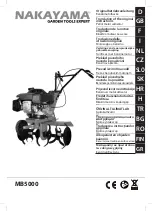
OPERATION
PRE-OPERATION CHECK LIST
(Operator’s responsibility)
•
Review and follow all safety rules and safety
decal instructions.
• Check that all safety decals are installed and
in good condition. Replace if damaged.
• Check to make sure all shields and guards are
properly installed and in good condition.
• Check that all hardware is properly installed
and secured.
• Check to be sure engine is free of dirt and debris.
Pay particular attention to the cooling fins, governor
parts and muffler. Clean air intake screen. Check air
cleaner; service is necessary.
• Inspect area. Remove stones or other hard objects
that might cause damage.
• Check that there are no underground utilities and
sprinkler heads in work area.
• Check all lubrication points and grease as
instructed in manual.
• Perform a functional check of the safety interlock
system each time you operate the unit. If it doesn’t
work, repair before using the machine
.
READ SAFETY SIGNS
!
WARNING
!
WARNING
ALL GUARDS MUST
BE IN PLACE WHILE
MACHINE IS IN OP-
ERATION.
KEEP HANDS AND
FEET AWAY FROM
MOVING PARTS.
BEFORE STARTING THE ENGINE
1. Be familiar with the controls, how each functions, and
what each operates.
2. Check engine oil level. Add oil if necessary, following
the engine manufacturer’s recommendations. Refer to
engine manual supplied with machine.
Engine Oil Level Check
a. BEFORE CHECKING ENGINE: make certain
the engine is level the engine switch is in the OFF
position.
b. Remove the filler cap/dipstick and wipe it clean.
c. Insert and remove the dipstick without screwing it
into the filler neck. Check the oil level shown on
the dipstick.
d. If the oil level is low, fill to the edge of the oil filler
hole with the recommended oil. SAE 10W-30 is
recommended for general use. Refer to engine
oil recommendations in engine manual for other
viscosities and information.
e. Screw in the filler cap/dipstick securely.
3. If applicable, check engine crankcase and gear
reduction case oil levels with the engine resting in a
level position. Add oil if necessary. (Refer to engine
manufacturer’s manual for the correct type and
amount of oil.
4. Open the fuel valve.
5. Fill the fuel tank with the amount and type of fuel
recommended by the engine manufacturer
.
Start Engine Safely
Make sure hands and feet are out of the way of mov-
ing parts when starting engine.
Starting Engine
1. Turn fuel cock to the “open” position.
2. Turn choke on (closed).
3. Turn ignition switch to “on”.
4. Pull recoil starter rope until engine starts.
5. After engine is warm, turn off choke (open).
6. Allow engine to run one minute before aerating.
7. Check engine rpm setting before operating. DO NOT
exceed 3600 rpm.
Transporting Aerator
1. Raise tines before transporting unit across surfaces
or before transporting from one work area to another
by lifting up on the lowering handle.
2. Turn choke on (closed).
3. Turn ignition switch to “on”.
4. Pull recoil starter rope until engine starts.
5. After engine is warm, turn off choke (open).
6. Allow engine to run one minute before aerating.
7. Check engine rpm setting before operating. DO NOT
exceed 3600 rpm.
10
AERATOR
































